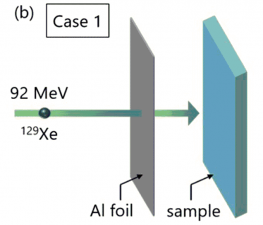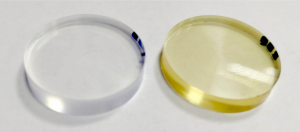How does electronics deal with ionizing radiation?
17-11-2022
 Necessary in most branches of physics, detection systems are largely based on electronic systems. Many of such systems operate in conditions of exposure to ionizing radiation, which is why research is constantly being carried out, e. g. on semiconductors, scintillators or photomultipliers in order to better understand their behavior in such an environment.
Necessary in most branches of physics, detection systems are largely based on electronic systems. Many of such systems operate in conditions of exposure to ionizing radiation, which is why research is constantly being carried out, e. g. on semiconductors, scintillators or photomultipliers in order to better understand their behavior in such an environment.
Semiconductors with a wide band gap have found application in electronic systems, especially in optoelectronics. Materials such as gallium nitride (GaN) and indium gallium nitride (InGaN) are used to produce, among others, LEDs, laser components or transistors. Their use in sensors and photodetectors is also being investigated. These types of nitrides show high resistance to high temperatures and radiation, so they are an excellent material for the production of photovoltaic panels for use in satellites.
While gallium nitride is a very thoroughly researched semiconductor, in the case of InGaN the effects of ionizing radiation are not exactly known and new experiments and research on this material are still being carried out. The results of research conducted at the Instituto Superior Técnico, Universidade de Lisboa in cooperation with the Department of Plasma and Ion Technologies of the National Center for Nuclear Research were published in October in the journal Physical Chemistry Chemical Physics. The article titled „Damage in InGaN/GaN bilayers upon Xe and Pb swift heavy ion irradiation” was named 2022 HOT Article by the journal’s publishers.
As part of the experiment conducted by the authors, samples consisting of InGaN and GaN layers were irradiated. They were deposited on a sapphire substrate and irradiated with beams of xenon and lead ions with energies of several tens of MeV and over 1 GeV, respectively, i. e. classified as swift heavy ions (SHI). The samples, both before and after irradiation, were examined for radiation damage. For this purpose, the researchers used the techniques of backscatter spectrometry, X-ray diffraction and Raman spectroscopy.
Based on the analyses, the scientists concluded that InGaN is more susceptible to ionizing radiation than pure gallium nitride, and the higher energy of the ions interacting with the material did not result in a drastic increase in the amount of damage. „Ions interacting with semiconductors can cause the formation of so-called tracks along which the material undergoes a phase change and simply melts, which changes its properties” – describes Przemysław Jóźwik, PhD., from the Department of Plasma and Ion Technologies of the National Center for Nuclear Research, the first author of the paper. „As it cools, the crystal structure can be partially rebuilt. Research shows that pure gallium nitride has a greater ability to rebuild than InGaN. When the indium nitride content is increased, stable defect clusters can form in the semiconductor, which makes recrystallization difficult. In turn, changes in the crystal structure can change material properties, such as the energy gap width of a semiconductor. „
The research results were supported by Monte Carlo simulations in the McChasy-1 program, which was created and is still being developed at NCBJ. „Thanks to the combination of experiment and simulation, we found out that the subsurface area of the tested materials is the most susceptible to damage due to interaction with fast heavy ions (SHI)” – added PhD. Jóźwik. „This is an important clue, for example, for the production of electronics that would be used in space, in high-energy physics experiments or in military applications. „
There are commercial materials available on the semiconductor market specifically designed for exposure to ionizing radiation, the so-called rad-hard materials (radiation hardened). Their increased resistance to radiation may result from both the production technology used and hardware solutions that compensate for the effects of potential radiation damage. However, their use is declining nowadays. This is due to the rapid technological development of electronics, which the market of materials resistant to radiation damage is unable to keep up with. In addition, in order to maintain performance on par with modern technologies, commercial rad-hard chips very often have larger sizes, weight and power consumption. For this reason, a thorough understanding of the properties of materials and their sensitivity to potential radiation damage is of great practical importance.
The problem of exposure of electronic components to damage caused by ionizing radiation is an important element of research, also in other NCBJ Departments, especially in connection with the preparation of equipment for space missions. „Researchers from the Department of Nuclear Apparatus and Technologies of the National Center for Nuclear Research are taking part in the preparation of the POLAR-2 experiment, which is to be placed on board the Chinese Space Station (CSS) in the coming years” – says MSc. Eng. Dominik Rybka from the Department of Electronics and Detection Systems. „The nature of the experiment studying the polarization of gamma-ray bursts, and the very fact that it is placed in an orbit 340-420 km above the Earth’s surface, makes its components vulnerable to cosmic radiation. „Tests are carried out on the resistance of individual elements, such as scintillators and photomultipliers, to damage caused by interaction with protons (accounting for almost 90% of cosmic radiation), but also to ready-made systems. This type of research is quite a challenge. Rad-hard components are currently only used in high-budget space missions and where they must perform critical functions from the point of view of system reliability. In low-budget missions, but also in large satellite constellations, engineers choose elements from, for example, the automotive industry, which are characterized by high durability, especially to extreme temperatures. These elements are then tested for resistance to radiation damage to ensure that during the mission the dose of ionizing radiation they receive will not cause their malfunction or complete damage. „There are really no cheap solutions, if we are looking for reliability” – adds PhD. Eng. Tomasz Rajkowski from the Department of Electronics and Detection Systems. „Either we pay the manufacturer of the rad-hard components, or we incur the cost of radiation qualification performed on our side. Looking for savings most often involves sacrificing some reliability – and that too can be acceptable, as long as the main assumptions of the mission are met. ”
A common method used to determine the dose that electronic components can take is to expose them to radioactive sources such as cobalt-60. In the Department of Electronics and Detection Systems, in cooperation with the Department of Physics and Particle Acceleration Technology, an alternative method is being tested: the use of linear electron accelerators, which, as a result of the collision of electrons with a tungsten target, produce X-ray beams. These studies are carried out as part of the development of system tests, but they are also beginning to be used commercially, e. g. for companies from the Polish space industry.
The components of the accelerators themselves, both industrial and medical, are also exposed to ionizing radiation. In the accelerators that the NCBJ deals with, e. g. Department of Nuclear Equipment HITEC, matrices and controllers are used that are more resistant to radiation, and their selection is the result of many years of design experience.
In addition to protons and gamma radiation, scientists are also studying the effect of neutron radiation, e. g. on scintillators. Irradiation of such materials with neutron beams is carried out by scientists from the Department of Nuclear Equipment and Techniques of the NCBJ and the Reactor Research Department of the NCBJ. Tested samples are placed in the core of the MARIA research reactor. In this way, the EJ-276 scintillator, used in fast neutron detectors, was irradiated.
The issue of the resistance of materials to radiation damage – both construction materials and materials used in electronic systems – is an important part of research in many branches of physics, from space missions to industrial and medical accelerators. Research methods are still being improved, and numerical tools are increasingly used to search for new solutions. The cooperation of scientists dealing with areas that are often very distant from each other is developing.
Science publications:
P. Jóźwik et al. Damage in InGaN/GaN bilayers upon Xe and Pb swift heavy ion irradiation, Phys. Chem. Chem. Phys., 2022, 24, 25773, https://doi.org/10.1039/D2CP02526D
Mianowski, S, De Angelis, N., Hulsman, J. et al. Proton irradiation of SiPM arrays for POLAR-2. Exp Astron (2022). https://doi.org/10.1007/s10686-022-09873-6
S Mianowski et al. Neutron hardness of EJ-276 scintillation material, 2020 JINST 15 P10012, https://doi.org/10.1088/1748-0221/15/10/P10012





